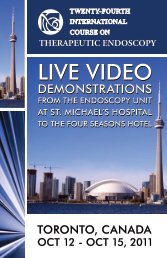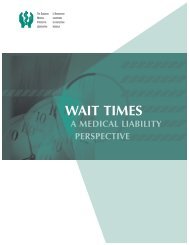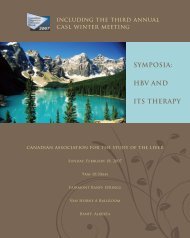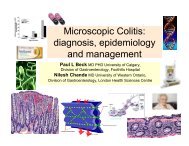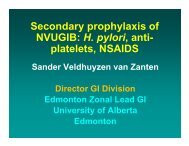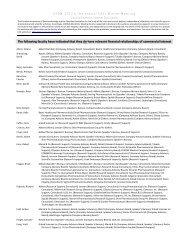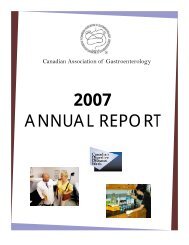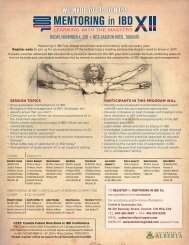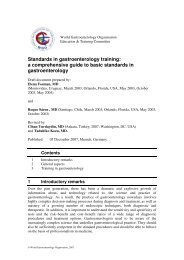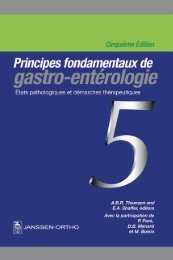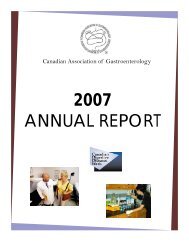Manifestations of Gastrointestinal Disease in the Child
Manifestations of Gastrointestinal Disease in the Child
Manifestations of Gastrointestinal Disease in the Child
Create successful ePaper yourself
Turn your PDF publications into a flip-book with our unique Google optimized e-Paper software.
682 FIRST PRINCIPLES OF GASTROENTEROLOGY<br />
communication disorder between <strong>the</strong> central nervous system and enteric<br />
nervous system (<strong>the</strong> “bra<strong>in</strong>-gut axis”). The enteric nervous system, which has<br />
been called <strong>the</strong> “m<strong>in</strong>i-bra<strong>in</strong>,” communicates with <strong>the</strong> central nervous system<br />
but also acts autonomously. It has three categories <strong>of</strong> neurons: sensory<br />
neurons, <strong>in</strong>terneurons and motor neurons, and a library <strong>of</strong> programs that determ<strong>in</strong>e<br />
patterns <strong>of</strong> gut behavior. The sympa<strong>the</strong>tic and parasympa<strong>the</strong>tic nervous<br />
systems transmit signals between <strong>the</strong> central nervous system and <strong>the</strong> gut. Afferent<br />
signals from <strong>the</strong> viscera will normally result <strong>in</strong> sensations such as hunger<br />
and satiety but will sometimes result <strong>in</strong> feel<strong>in</strong>gs <strong>of</strong> pa<strong>in</strong> or nausea. Highamplitude<br />
contractions, lum<strong>in</strong>al distention and <strong>in</strong>flammation can all produce<br />
pa<strong>in</strong>ful sensations. It is currently hypo<strong>the</strong>sized that functional abdom<strong>in</strong>al pa<strong>in</strong>,<br />
particularly <strong>in</strong> IBS may result from visceral hypersensitivity with <strong>in</strong>creased<br />
afferent signals from <strong>the</strong> gut. Possible triggers for this <strong>in</strong>crease <strong>in</strong> afferent<br />
signals <strong>in</strong>clude preced<strong>in</strong>g <strong>in</strong>fection, trauma and allergy. Developmental and<br />
genetic factors are also likely <strong>in</strong>volved. The central response to <strong>the</strong>se afferent<br />
signals may also be magnified. In this situation even physiologic<br />
sensory <strong>in</strong>put from <strong>the</strong> gut may be <strong>in</strong>terpreted as discomfort. Stress, anxiety<br />
and depression modify <strong>the</strong> physiologic state which <strong>in</strong> turn can alter not only<br />
<strong>the</strong> perception <strong>of</strong> pa<strong>in</strong> but also <strong>in</strong>test<strong>in</strong>al motor and secretory function.<br />
The morbidity result<strong>in</strong>g from functional abdom<strong>in</strong>al pa<strong>in</strong> syndrome <strong>of</strong>ten<br />
relates more to <strong>the</strong> <strong>in</strong>dividual, family and school responses to <strong>the</strong> symptoms,<br />
ra<strong>the</strong>r than <strong>the</strong> severity <strong>of</strong> <strong>the</strong> symptoms <strong>the</strong>mselves. Because <strong>of</strong> <strong>the</strong> potentially<br />
complex <strong>in</strong>teractions between biological, psychological and social factors,<br />
children with functional abdom<strong>in</strong>al pa<strong>in</strong> are best assessed and managed us<strong>in</strong>g a<br />
bio-psycho-social model <strong>of</strong> disease.<br />
1.3 Cl<strong>in</strong>ical Evaluation<br />
The history and physical exam<strong>in</strong>ation are important, not only <strong>in</strong> evaluation,<br />
but also <strong>in</strong> <strong>the</strong> successful management <strong>of</strong> children with functional gastro<strong>in</strong>test<strong>in</strong>al<br />
disorders. A diagnosis <strong>of</strong> functional abdom<strong>in</strong>al pa<strong>in</strong> can be strongly<br />
considered if a history has been elicited that is typical <strong>of</strong> functional pa<strong>in</strong>, with<br />
no symptoms suggestive <strong>of</strong> organic disease, and <strong>the</strong> physical exam<strong>in</strong>ation is<br />
normal. Education <strong>of</strong> <strong>the</strong> family about <strong>the</strong> nature <strong>of</strong> this condition can <strong>the</strong>refore<br />
<strong>of</strong>ten beg<strong>in</strong> at <strong>the</strong> first visit.<br />
The characteristic pattern <strong>of</strong> functional abdom<strong>in</strong>al pa<strong>in</strong> <strong>in</strong>cludes:<br />
1. Pa<strong>in</strong> is localized <strong>in</strong> <strong>the</strong> umbilical to mid-epigastric region, but sometimes<br />
poorly localized and felt all over <strong>the</strong> abdomen.<br />
2. Pa<strong>in</strong> does not radiate.<br />
3. Pa<strong>in</strong> may vary from mild to so severe that <strong>the</strong> patient may be pale and<br />
diaphoretic.



